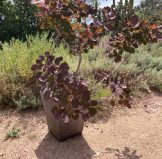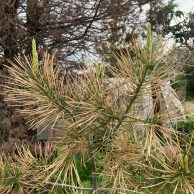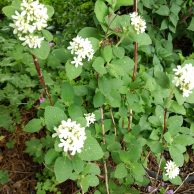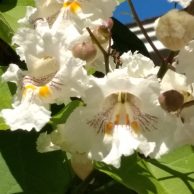 XERISCAPE TREES AND SHRUBS for SUN
XERISCAPE TREES AND SHRUBS for SUN
Harlequin’s Gardens 303-939-9403 www.harlequinsgardens.com
Note: plants listed in bold are native to our region
TREES
Acer ginnala / Amur maple
Acer ginnala ‘Compacta’ / Dwf. Amur Maple
Acer grandidentatum / Bigtooth Maple
Acer negundo / Boxelder
Acer negundo ‘Sensation’ / ‘Sensation’ Boxelder, male selection
Acer tataricum ‘Hot Wings’ / Hot Wings Tatarian Maple
Aesculus glabra / Ohio Buckeye
Amelanchier utahensis / Utah Serviceberry
Catalpa speciosa / Western Catalpa
Celtis occidentalis / Western Hackberry
Celtis reticulata / Netleaf Hackberry
Crataegus ambigua / Russian Hawthorn
Crataegus crus-galli / Cockspur Hawthorn
Crataegus mollis / Downy Hawthorn
Crataegus monogyna / Singleseed Hawthorn
Crataegus phaenopyrum / Washington Hawthorn
Cupressus arizonica / Arizona Cypress
Gleditsia triacanthos inermis / Honeylocust
Gymnocladus dioica / Kentucky Coffeetree
Juniperus monosperma / One-seed Juniper
Juniperus scopulorum & selections / Rocky Mt. Juniper
Koelreuteria paniculata / Goldenrain Tree
Malus species / Flowering Crabapple selections
Morus alba / White Mulberry
Pinus aristata / Bristlecone Pine
Pinus cembroides edulis / Pinyon Pine
Pinus contorta v. latifolia / Lodgepole Pine
Pinus flexilis / Limber Pine
Pinus ponderosa / Ponderosa Pine
Prunus americana / American Wild Plum
Prunus padus / Mayday Tree, Bird Cherry
Prunus virginiana / Native Chokecherry
Prunus virginiana ‘Shubert’ / Canada Red Chokecherry
Prunus x virginiana ‘Sucker Punch’ / Non-suckering Chokecherry
Pseudotsuga menziesii v. glauca / Rocky Mt. Douglas Fir
Ptelea trifoliata / Wafer Ash, Hop Tree
Pyrus ussuriensis / Ussurian Pear
Quercus bicolor / Swamp White Oak
Quercus gambelii / Gambel Oak
Quercus macrocarpa / Bur Oak
Quercus muehlenbergii / Chinkapin Oak
Quercus undulata / Rocky Mt. Scrub Oak
Robinia neomexicana / New Mexico Locust
SHRUBS
Agave parryi ssp. neomexicana
Amelanchier alnifolia / Saskatoon Serviceberry
Amelanchier aln. ‘Regent’ / Regent Serviceberry
Amelanchier canadensis / Shadblow Serviceberry
Amelanchier laevis / Allegheny Serviceberry
Amorpha canescens / Great Plains Leadplant
Amorpha nana / Dwarf Leadplant
Artemisia cana / Silver Sagebrush
Artemisia filifolia / Sand Sagebrush
Artemisia tridentata / Tall Western Sagebrush
Artemisia versicolor (canescens) / Seafoam Sage
Atriplex canescens / Four Wing Saltbush
Atriplex confertifolia / Spiny Saltbush
Buddleia alternifolia ‘Argentea” / Silver Butterfly Bush
Buddleia dav. nanhoensis cultivars / Compact Butterfly Bush
Buddleia davidii cultivars / Butterfly Bush
Caragana arborescens / Siberian Peashrub
Caragana pygmaea / Pygmy Peashrub
Caryopteris x clandonensis cultivars / Blue Mist Spirea
Ceanothus fendleri / Mountain Lilac
Ceratoides lantana / Winterfat
Cercocarpus brevifolius / Little-flowered Mt. Mahogany
Cercocarpus intricatus / Littleleaf Mountain Mahogany
Cercocarpus ledifolius / Curl-leaf Mountain Mahogany
Cercocarpus montanus / Common Mountain Mahogany
Chamaebatieria millefolium / Fernbush
Chrysothamnus n. ssp. graveolens / Tall Grn. Rabbitbrush
Chrysothamnus naus. ssp. albicaulis / Tall Blue Rabbitbrush
Chrysothamnus naus. ssp. nauseosus / Dwf. Blue Rabbitbrush
Chrysothamnus viscidiflorus / Dwf. Grn. Rabbitbrush
Cotinus coggygria / Smoke Tree
Cotinus coggygria ‘Royal Purple’ / Royal Purple Smoke Tree
Cotinus x ‘Grace / ‘Grace’ Smoketree
Cotoneaster divaricatus / Spreading Cotoneaster
Cotoneaster lucidus / Peking Cotoneaster
Cotoneaster multiflora / Big-flowered Cotoneaster
Cowania mexicana (Purshia stansburyana) / Cliffrose
Cytissus purgans ‘Spanish Gold’ / Andora Broom
Cytissus scoparius ‘Moonlight’ / Moonlight Broom
Ephedra americana / American Ephedra
Ephedra viridis / Mormon Tea
Fallugia paradoxa / Apache Plume
Forestiera neomexicana / New Mexico Privet
Genista lydia / Lydian Broom, Dwarf Broom
Genista tinctoria / Woadwaxen
Hesperaloe parviflora / Red Yucca
Hippophae rhamnoides / Sea Buckthorn
Holodiscus dumosus / Rock Spirea
Ligustrum vulgare ‘Cheyenne’ / ‘Cheyenne’ Privet
Ligustrum vulgare ‘Lodense’ / Lodense Privet
Lonicera k. v. floribunda ‘Blue Velvet’ / Blue Velvet Honeysuckle
Lonicera syringantha v. wolfii / Tiny Trumpet Honeysuckle
Lonicera tatarica selections / Shrub Honeysuckle
Mahonia aqu. Compactum / Compact Oregon Grapeholly
Mahonia aquifolium / Oregon Grapeholly
Mahonia fremontii / Fremont’s Mahonia
Mahonia haematocarpa / Desert Holly
Opuntia species / Cholla Cactus
Perovskia atriplicifolia / Russian Sage
Philadelphus lewisii / Lewis Mockorange
Physocarpus opulifolius cultivars / Ninebark
Juniperus communus/Common Juniper selections
Prunus besseyi / Western Sandcherry
Prunus besseyi ‘Pawnee Buttes’ / Pawnee Buttes Sandcherry
Prunus besseyi ‘Boulder Weeping’ / Boulder Weeping Sandcherry
Prunus tenella / Dwarf Russian Almond
Purshia tridentata / Antelope Bitterbrush
Pyracantha coccinea / Firethorn
Rhamnus smithii / Smith’s Buckthorn
Rhus aromatica / Fragrant Sumac
Rhus glabra / Smooth Sumac
Rhus glabra v. cismontana / Rocky Mt. Sumac
Rhus trilobata / Threeleaf Sumac
Rhus typhina / Staghorn Sumac
Rhus typhina laciniata / Cutleaf Staghorn Sumac
Ribes aureum / Native Golden Currant
Ribes cereum / Wax Currant
Ribes odoratum / Golden Currant
Robinia neomexicana / New Mexico Locust
Rosa ‘Alba Maxima’
Rosa ‘Alba semi-plena’
Rosa ‘Alba Suaveolens’
Rosa ‘Felicite Parmentier’
Rosa ‘Fruhlingsgold’
Rosa ‘Golden Wings’
Rosa ‘Harison’s Yellow
Rosa ‘Henry Kelsey’
Rosa ‘John Cabot’
Rosa ‘John Davis’
Rosa ‘Konigen von Danemark’
Rosa ‘Lawrence Johnston’
Rosa ‘Maiden’s Blush’
Rosa “Banshee”
Rosa arvensis
Rosa ‘Complicata’
Rosa eglanteria / Sweetbriar
Rosa foet. Persiana / Persian Yellow Rose
Rosa foetida bicolor / Austrian Copper Rose
Rosa glauca (rubrifolia) / Redleaf Rose
Rosa hugonis / Father Hugo’s Rose
Rosa woodsii / Wood’s Rose
Rosmarinus officinalis ‘Arp’ / Arp Rosemary
Shepherdia argentea / Silver Buffaloberry
Robinia neomexicana / New Mexico Locust
Spiraea ‘Cheyenne Snowmound’
Spiraea jap. ‘Goldflame’ / Goldflame Spirea
Syringa patula ‘Miss Kim’ / Miss Kim Dwf. Korean Lilac
Syringa prestoniae cultivars / Canadian Lilacs
Syringa vulgaris cultivars / Common Lilacs
Yucca baccata / Banana Yucca
Yucca filamentosa / Adam’s Needle
Yucca glauca / Native Soapweed, Narrowleaf Yucca
Yucca harrimanii / Harriman’s Dwf. Yucca




 So they can support us!
So they can support us!